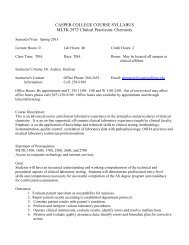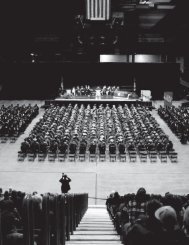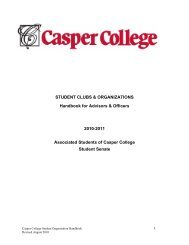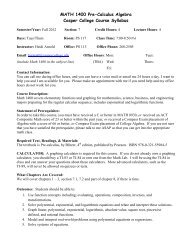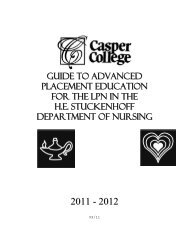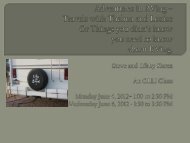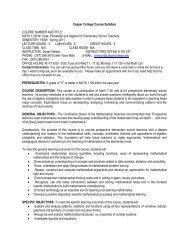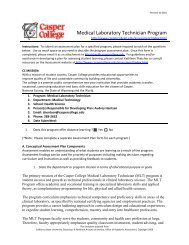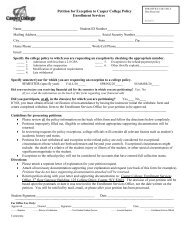Create successful ePaper yourself
Turn your PDF publications into a flip-book with our unique Google optimized e-Paper software.
As the year blossoms into spring, many journeysof adventure begin. Throughout time, spring wasthe season that major treks began, particularly thoseof the settlers on the plains of western America.Reverend Edward Evans Parrish documented hisjourney on the Oregon Trail from Hoskinsville,Ohio through the wide-open spaces to his destinationof the “Gap” farm in Oregon in a journal entitled“Crossing the Plains in 1844.” Parrish kept thisjournal throughout his trip from winter 1843 throughJuly 1845 with a final explanatory entry in 1863. Thefirst entry in 1844 begins his spring journey from thewinter encampment in Missouri:“On April 15, 1844, we landed on the bank of theMissouri River on the way to Oregon, and on the16th crossed all over safely and camped in the IndianTerritory, where I commenced anew to write adiary, having lost the one I kept during my journeyfrom Hoskinville to the neighborhood of Platte City[Mo.]. But O! the difficulties of this day incrossing the slough and bottom. After that we mireddown twice within less than a mile, so that we hadto unload in both cases. But, thank God for goodfriends, or without them we could not have gotalong. We passed through both mud and water andlanded safely at the foot of the bluff that evening.”Throughout the journey, triumphs as well as trialsabounded. Even death was ever present and recordedas well as evidenced by Parrish’s Monday, May 13entry:“All glad to see the light. News soon arrived ofthe loss of the Wolf River bridge, and also of thedeath of the sick man, Bishop, who was bound forthe Rocky Mountains for his health. He died atMosquito Creek...”Another rite of spring is marriage and even on theOregon Trail, weddings occurred with the ReverendParrish officiating:“Tuesday, May 21. -- ...Last night we had awedding in camp. Mr. Martin Gilliam to MissElizabeth Asabill by E.E. Parrish. Both young.Hope they may do well...”According to his journal, Parrish crossed the NorthPlatte River on August 12 and passed IndependenceRock on August 16 with an entry on August 24stating,“I am writing this in ‘Oregon’ this morning.”This photograph illustrates how wagon trains collected in towns like <strong>Casper</strong> along the trails to California, Oregon, andUtah. This photo is actually of the Gros Ventres and Sioux Indians passing through <strong>Casper</strong> on their way to Montana.Wagon training was not just for white pioneers, Native Americans also used them to move from point to point later in the19th century. <strong>Casper</strong>, Wyoming, 1891. Courtesy of Western History Collection, <strong>Casper</strong> <strong>College</strong> Western History Center.3
Up in Idaho entitled “On the Trail to Tomorrow.”Our final speaker of the night appealed to the youngermembers of the audience. Sarah Engstrom is a Senior GirlScout and a Girl Scout Counselor and Recruiter for juniorhigh school students. Sarah was also a delegate to the2005 Girl Scout National Congress representing Wyomingand a brief clip from that Congress was shown prior toSarah taking the stage. During 2005 she also earned notonly her God and Life Award but also her Gold Award, arare achievement indeed. Sarah challenged the young GirlScouts to not be defined by Girl Scout Cookies; however,if they were associated with the delicious treat, then theycould be “Tough Cookies!”Girl Scout Troop 1197 (Juniors, Cadets, and Seniors)assisted in the lobby with the Girl Scout display, passingout brochures, and selling those iconic annual treats!Numerous Girl Scouts, past and present, as well asmembers of the community, attended the event March 29to make it a rousing success!1 2543Clockwise from top left: 1. Girl Scout with Wyoming state flag waiting to march down the aisle (Troop 1155). 2. MaryHales, Girl Scout and speaker. 3. Girl Scout and speaker Bettie Marie Daniels. 4. Sarah Engstrom, Gold Award Girl Scoutand speaker. 5. Teri Hedgpeth, at the podium introducing next speaker.5
Cont. from page 1As early as 1914, Buffalo BillDepression and World War II.Cody appeared at the Iris, whichHowever, in 1957, the Rex Theatrealong with the America, Wyoming,finally closed its doors leaving theColumbia, and Rialto, all featuredAmerica and the Rialto Theatres,vaudeville performances with awhich continue to operate today.variety of entertainment.The Schulte family’s longThe six theatres continued tohistory with the downtownoperate successfully until 1923 whentheatres went through somethe Hub Theatre closed its doors.transitions as well as theThe Wyoming Theatre went out ofactual theatre starting in 1962business in 1924. In an effort to savewhen Russell Schulte leasedthe Columbia Theatre, E.J. Schulte,the America and the RialtoM.S. Kenney and M.H. Todd ofto Commonwealth Theatresthe Rialto Theatre Company took it American Theatre. 119 South Center, <strong>Casper</strong>, Wyoming. for the next 25 years untilover; however, the Columbia was also Built in 1918. Movies on the marquee were first released Commonwealth, which alsoeventually forced to close its doors in in 1929. Courtesy of Fredric Schulte Family Collection, operated the Eastridge Mall1928. By the end of 1928 only three <strong>Casper</strong> <strong>College</strong> Western History Center.theatres, decided to close them.theatres were left downtown, theJust three days after theRex, formerly the Iris, America, and Rialto Theatres. theatres’ closing in 1987, new owner Fred Schulte, son ofThe biggest change to the <strong>Casper</strong> theatres came in August Russell Schulte, re-opened them. For several years, the1928, when theatre owner E.J. Schulte installed Vitaphone Schulte family business, Rialto Theatre Inc., continued to ownequipment at the Rialto. This new equipment enabled patrons the theatres after leasing them to <strong>Casper</strong> Movie Palace, Inc.,not only to see the film but also to hear the actors on the which eventually purchased both the Rialto and the America.screen.In 2012, 90 years after opening, the America and the RialtoBy 1929, E.J. Schulte, consolidated the Rex, America, and continue to draw movie fans to downtown <strong>Casper</strong>. In addition,Rialto Theatres under his ownership. The three theaters, in recognition of its historic signifigance, the Rialto is listedwhich had all been constructed as silent movie venues, on the National Register of Historic Places.successfully made the transition to talking pictures. Inaddition, all three theatres managed to survive the GreatEditor’s Note: Following the death of Fred Schulte in 2008, his sons, Dan and Steve Schulte, made available to the Western History Centervaluable archival materials related to the Schulte family’s long association with the Rialto and America Theatres.“Early Days at Salt Creek and Teapot Dome”By Ed Bille, edited by Arlene Larson, 1978It is stated inside the cover of this book that it is “Apictorial history of two central Wyoming fields – onefamous, one notorious –.” And truly this book is that.Using maps and photographs, we see the development ofthe Shannon Oil Field in 1889, and the beginnings of thelarge Midwest Oil Company with its headquarters in <strong>Casper</strong>through the 1920s. We also get a history of the scandalsurrounding the leasing of the Teapot Dome Oil Fieldthrough photographs, newspaper headlines, and politicalcartoons gathered by Ed Bille in this work.However, for Midwest, Edgerton, and former Salt Creek,Lavoye, Teapot, Columbine, and Snyder residents, thisbook is so much more than just a history of the oil fields.Bille’s work also traces the development and demise of theboomtowns associated with the fields – towns that boastedfootball games under lights, indoor swimming pools,theaters, dance halls, and packed boarding houses anddining halls. To tell this history, Bille draws on numerousformer residents who trace the outlines of the formerboomtowns and reminisce over the heydays of Lavoye, SaltCreek, and Snyder.The oil fields and towns flourished through the 1920s; butsoon thereafter, wells were drilled in other states and the oilindustry moved with them. When that happened, the oncethriving towns died and of those boomtowns that sprang uponly Midwest and Edgerton survived. Bille’s book is filledwith numerous photographs from the 1920’s boom as well asphotographs from the 1970s showing the ghostly outlines offoundations that supported businesses, schools, and homes.Ed Bille’s notebooks and photographs that he compiledfor this work are now stored at the Salt Creek Museum inMidwest. A trip to the museum, where one can see firsthandrelics of what Bille detailed in his book, is well worththe short drive from <strong>Casper</strong>.6
One of our new work study students this semester is CarolineM. S. Johnson, more commonly known as C. J. Born inDenver, Colorado and raised in Salt Lake City, Utah, C. J.moved back to <strong>Casper</strong> to be with her fiancé. This past August,C.J. and Killian were married.which she sells during the summer, and the sport of archery.With her unique style and distinctive flair, C. J. brings amuch welcome splash of color to the Western History Center,and we are happy to have her.Our second work study spotlight for this newsletter is AlexAsherin. Alex comes to us from another sister state, Mitchell,South Dakota. He decided to attend <strong>Casper</strong> <strong>College</strong> because hehad a friend attend here and was pleased with how relativelyinexpensive <strong>Casper</strong> <strong>College</strong> is to other institutions.Caroline M.S. “C.J.” Johnson.C. J. is an anthropology major which is, as she puts it, “thestudy of humans throughout time and all places.” She alsostudies archeology, which is a subdivision of anthropology.C. J. decided on this course of study because she has beeninterested in it her whole life.After studying at <strong>Casper</strong> <strong>College</strong>, C. J. wants to go toSeattle or North Carolina to get a doctorate in anthropology.After that, she plans to teach during the year and travel todigs and research sites in her off time. C. J. is excited aboutarcheological and anthropological finds in the Baltic Sea,where researchers are finding villages in the sea largelypreserved due to the lack of oxygen in the water.C. J. is often the first person you see upon entering theWestern History Center and is always ready to help researchersand students navigate their way through the collections. Overthis semester, C.J. has also taken the lead in such projectsas labeling our newspaper collections and organizing <strong>Casper</strong><strong>College</strong> records. She is the main cog in the machine that keepsus running on track by taking care of a multitude of WHCadministrative tasks.With an 18 credit-hour load this semester, sleeping is C. J.’sbiggest hobby. She also enjoys making jewelry and clothing,Alex Asherin.Alex is a psychology major and plans to continue on to afour-year university after graduating from <strong>Casper</strong> <strong>College</strong>.He is not sure where yet, but is considering Northern StateUniversity in South Dakota or Colorado State. Alex says hedecided to major in psychology because he “relates to otherpeople well and likes to help others.”Since Alex has started working at the Western HistoryCenter, he has taken the lead in various projects includingcopying our backup disks to our new network, scanningdocuments, and a myriad of data entry jobs. Most of his time,however, is spent updating the obituary database. It has beenyears since new entries have been added, so this is a hugeproject, spanning hundreds of newspapers.Alex likes listening to music, to the point where you willprobably hear Alex before you see him, even when he is usinghis headphones. He also enjoys computers, sports, hangingout with friends, and swimming.7
Our volunteer spotlight this newsletteris Elaine Hough. Often seen in theWestern History Center when it is timeto put together the newsletter, Elaine isinstrumental in the publication of theWestern History Chronicle. A journalistand public relations specialist by professionand historian by nature, Elaine freelygives her time and unique experience tomake this publication possible.Elaine was born in Buffalo, Wyoming,where her family has lived since 1881. Herfather, William C. Holland, was a lawyer,historian, and politician, and was a greatinfluence on her life, especially in gettingElaine involved in the study of history. AsElaine puts it, “You don’t know who youare until you know where you came from”and she and her family often sat andtalked about their past.Elaine started her pursuit of journalismworking for the Buffalo Bulletin, a weeklynewspaper that is still in print today. Shewrote history features and laughs as sherecalls being paid the sum of 10 cents perinch. She went on to obtain a journalismdegree from the University of Colorado.Unsurprisingly, she also received a minorin history. After receiving her degree,Elaine worked on various weekly anddaily newspapers, including the <strong>Casper</strong>Star-Tribune. At the Tribune Elaine wasthe Women’s Editor (Lifestyle Editor) forfive years.In 1977, Elaine left behind thenewspaper business and, as a “naturalprogression” as she calls it, startedworking at the Wyoming Medical Centeras their public relations department.When she first started, the only “office”the hospital had for her was a smallcloset by the laundry facilities. But inthat closet, Elaine wrote the quarterlypublication, the Outreach, wrote theHospital Highlights newsletter, compiledthe mailing list, applied for post officepermits, printed, and mailed the hospitalpublications.During her time at the WyomingMedical Center, Elaine was also in chargeof volunteer services. She managed 200volunteers and redid the youth volunteerprogram. Elaine served in volunteerservices for 13 years, and, always thejournalist, also wrote a newsletter andpress releases for them.Eventually, Elaine became the hospitalhistorian. All the while she was workingat the Wyoming Medical Center. She waspreserving the history of the hospital.And as people found out what she wasdoing, more people donated to the cause.After working at the hospital for 27years, Elaine retired. She contacted theformer archivist here at the WesternHistory Center, Kevin Anderson, andrealized that the best place for all ofthe hospital’s historical records wouldbe here. At Elaine’s prompting, thehospital donated their historical records.In addition, Blue Envelope donated theirrecords as well. All of these records,including a large collection of photographsall through the years, are now housed atthe Western History Center.As a volunteer here, Elaine is the editorof this Western History Chronicle, a jobshe loves. She writes feature articles, doesresearch, and continues to be nosey bynature. She really enjoys the WesternHistory Center, being up here, andworking up here. Steeped in history fromthe beginning, Elaine is right at home,delving into and writing about history. “Itis the best of both worlds,” she says, “It’sme.”April 28, 1896 – A treat signed by Chief Washakie of theShoshone and Chief Sharp Nose of the Arapahoe ceded about10 square miles of the Hot Springs at Thermopolis to the UnitedStates for about $60,000 worth of cattle and food. The sumwas considered largely symbolic so the transaction is oftencalled “The Gift of the Waters.” Thermopolis is home to theworld’s largest mineral hot springs, which was historically, andis today, used for its therapeutic benefits.May 22, 1899 – Shoshone River water rights were granted toWilliam F. Cody, better known as Buffalo Bill. The waterrights were acquired from the State of Wyoming for theirrigation of 60,000 acres of land in the vicinity of the quicklyexpanding town of Cody.Thermopolis Hot Springs, February 1985. Photograph by Tom Bishop.Courtesy of <strong>Casper</strong> Star-Tribune Collection, <strong>Casper</strong> <strong>College</strong> WesternHistory Center.8June 1, 1909 – The Pathfinder Dam was completed. The dam islocated in a canyon about 50 miles southwest of <strong>Casper</strong> on theNorth Platte River. The structure includes three permanentdams, three outlet tunnels and several distributing canals. Ittook about four years to complete, at a cost of $1,200,000.
Photographic –• Photographs (16) of Sally and Paddy Force and Haley’sRiverside Poultry Farm during demolition donated by Donand Jan Anderson• Historic postcard – “The Goose Egg: From an OriginalPainting by Dolph,” donated by Myrtie PetersonPhysical Items –• Historic Girl Scout uniforms, badges, pins, and memorabiliadonated by Mary HalesMaps –• Printed copy of 1911 Clason’s Industrial Map of Wyoming,donated by Ron RiceManuscript –• Two journals of the American Beauty Thimble Club withtheir minutes – 1942-1954• W.G. Bridge Club minutes 1934-1947• Neighbors of Woodcraft Circle 409 – 1947-1955 withAmerican Beauty Thimble Club, all donated by HeatherHuber• Article on J.B. Okie from Old West Journal; printed LostCabin connection from Ed Johnson; copy of a letter fromA.C. “Clay” Arwood to the Johnson Family from 1976,donated by C. Ed Johnson• “A Nostalgic View of <strong>Casper</strong> and Surrounding Areas fromthe Past to the Present” by Kathy Schierenberg Loomis andDebbie Loomis Beaverson, donated by Steve Pfaff• The Cadoma Foundation Historic Calendar for 1928 (2012),donated by Susan Bishop• Donated by Jackie and Pinky Ellis:- Letter of Frank and Briged Ellis from Department ofInterior and Attorney Seymour S. Bernfeld 1937 to 1945regarding the Taylor Grazing Act and Leasing of U.S.Open Range- Printed copy of “History of Niethammer” written byHerman Hiethammer, 1963 and letter from Tom Stroockto William Muller 2009- Copy of “Home on the Range” by Brewster Higley andDaniel Kelley and history of the song by Mark Steyn• “Girl Scout Time Line for Dorothy Burger Bullard,”personal memories as a Girl Scout in <strong>Casper</strong>, Wyoming,donated by Dorothy Bullard• “My Story” by Mary Michie Logasa Mazzone, donated byMary Fremont Michie Lagasa• Copy of “The Wyoming North and South Railroad: 1923-1935” by James A. Brown, Jr, donated by Fred Eiserman• Original daily “Diaries of Henry Farra” from 1873, 1878,and 1888, donated by Vince Crolla• Collection description: Three scrapbooks of Good Samphotographs from 1995-2004, donated by Don and JanAnderson• OCTA (Oregon California Trails Association) Minutes 1988– 2009, donated by OCTABooks –• “The Western Planner Journals from 1992” donated byWestern Planning Resources• “Natrona County: People, Place and Time” by RebeccaHunt donated by Rick Young of Fort Caspar Museum• An Indexed and Annotated Bibliography on the Ecologyof Grand Teton National Park (1979), donated by <strong>Casper</strong><strong>College</strong> Goodstein Foundation Library• “Natrona County: The Place We Call Home,” donated bythe Natrona County Public Library Foundation and BillNelson• Full set of 2007 Wyoming Statutes, donated by Vince Crolla• Four Johnson County school books donated by Shirley JacobNewspapers –• <strong>Casper</strong> Star Tribune Dec. 5-7, 1966 (hard copy, loose) andDenver Post Jan. 27, 1935 (comic section, loose) and DenverPost Sept. 23, 1945 (Sunday insert only, loose), donated byBrian EarlMedia –• DVD copy of “Follow Me, Girls, A Girl Scout Valentine,”donated by Janet de Vries• Digital copy of booklet: “Something for the Girls inWyoming” by Bettie Marie Daniels, 1977, donated by Janetde VriesOral Histories –• Jean Tichenor• Burt Noe• Thomas Clemmons• Mary Hales• Sarah Engstrom• Albert “Al” Allen• Charlotte Babcock• Lois Shickich #2 – <strong>Casper</strong>, Wyoming Girl Scout experiences• William “Bill” MullerCash Donations –• Your name hereCan you identify thepeople in this photo?Call Teri at 307-268-2680 orhedgpeth@caspercollege.edu.9
CHANGE SERVICE REQUESTEDWestern History Center<strong>Casper</strong> <strong>College</strong>125 <strong>College</strong> Drive<strong>Casper</strong>, WY 82601Non-Profi t OrganizationU.S. PostagePAIDPermit No. 112<strong>Casper</strong>, WY 82601The Rialto Theatre, ownedby the Schulte Family, was oneof three theatres the familyowned in <strong>Casper</strong> along withthe America Theatre and RexTheatre. The Rialto BarberShop, the Rialto Cigar Store, andRialto Billiard Parlor, located inthe basement, were also locatedin the same building.In 1933 King Kong came to<strong>Casper</strong>. Seen here are <strong>Casper</strong>boys waiting for the Rialto toopen its doors in order to see“The Strangest Story EverConceived by Human Mind.”Faint in the background (infront of the A & L in Rialtounder the arch) is a giant posterof King Kong with Fay Wray inhis grasp.10



